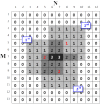Tool to visualize and evaluate operator proficiency in laser hair-removal treatments
- PMID: 24708724
- PMCID: PMC4005832
- DOI: 10.1186/1475-925X-13-40
Tool to visualize and evaluate operator proficiency in laser hair-removal treatments
Abstract
Background: The uniform delivery of laser energy is particularly important for safe and effective laser hair removal (LHR) treatment. Although it is necessary to quantitatively assess the spatial distribution of the delivered laser, laser spots are difficult to trace owing to a lack of visual cues. This study proposes a novel preclinic tool to evaluate operator proficiency in LHR treatment and applies this tool to train novice operators and compare two different treatment techniques (sliding versus spot-by-spot).
Methods: A simulation bed is constructed to visualize the irradiated laser spots. Six novice operators are recruited to perform four sessions of simulation while changing the treatment techniques and the presence of feedback (sliding without feedback, sliding with feedback, spot-by-spot without feedback, and spot-by-spot with feedback). Laser distribution maps (LDMs) are reconstructed through a series of images processed from the recorded video for each simulation session. Then, an experienced dermatologist classifies the collected LDMs into three different performance groups, which are quantitatively analyzed in terms of four performance indices.
Results: The performance groups are characterized by using a combination of four proposed indices. The best-performing group exhibited the lowest amount of randomness in laser delivery and accurate estimation of mean spot distances. The training was only effective in the sliding treatment technique. After the training, omission errors decreased by 6.32% and better estimation of the mean spot distance of the actual size of the laser-emitting window was achieved. Gels required operators to be trained when the spot-by-spot technique was used, and imposed difficulties in maintaining regular laser delivery when the sliding technique was used.
Conclusions: Because the proposed system is simple and highly affordable, it is expected to benefit many operators in clinics to train and maintain skilled performance in LHR treatment, which will eventually lead to accomplishing a uniform laser delivery for safe and effective LHR treatment.
Figures










References
-
- ASAPS 2012 Cosmetic Surgery National Data Bank Statistics. 2012. [ http://www.surgery.org/sites/default/files/ASAPS-2012-Stats.pdf] - PubMed
-
- Lapidoth M, Dierickx C, Lanigan S, Paasch U, Campo-Voegeli A, Dahan S, Marini L, Adatto M. Best practice options for hair removal in patients with unwanted facial hair using combination therapy with laser: guidelines drawn up by an expert working group. Dermatol. 2010;221(1):34–42. doi: 10.1159/000315499. - DOI - PubMed
Publication types
MeSH terms
LinkOut - more resources
Full Text Sources
Other Literature Sources
Miscellaneous

